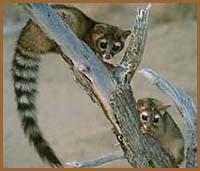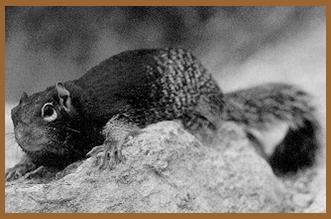Guide to SA Natural Areas & Greenway Trails
N: AREA WILDLIFE

Ringtail Cat (Bassariscus astutus) from USDA Forest Service
Christine Westerman, Office Lead, SWCA Environmental Consultants, San Antonio office, is the author of this piece.
MULTIPLE ECO-REGIONS MEANS DIVERSE WILDLIFE
Ten eco-regions have been delineated in Texas. An eco-region is a major natural area defined by important ecological factors such as vegetation type, geology, soils, topography, and rainfall. Phil Hardberger Park is located in a unique area of Bexar County where three of these eco-regions converge: Edwards Plateau (or what we think of as “Texas Hill Country”), Blackland Prairies (or native grasslands), and South Texas Plains (what we often call “Brush Country”).
What eco-region are you standing in now? What factors help identify it?
The science of ecology explores how plants and animals interact with their environment. Ecology tells us that different environments will support different types of plants and animals. Because of the amazing convergence of ecological areas in Phil Hardberger Park, there is a surprising variety of wildlife species that make their homes here. Initial wildlife studies conducted during park planning in 2007 identified 51 species of birds within the park! Biologists also observed nine species of mammals, five species of reptiles and amphibians, and ten species of butterflies.
PHIL HARDBERGER EAST, INCLUDING RIPARIAN AREA
By exploring the different ecosystems of the park, you will have the opportunity to observe many different species of wildlife. On the northeast end of Phil Hardberger Park (East), along Salado Creek, you may find species that prefer the riparian corridor (“riparian” means the type of vegetation that occurs along a river or creek), because vegetation is denser and trees are taller in these areas. These riparian areas support species like rock squirrels. These dark-colored, large ground squirrels are excellent climbers, preferring to make their dens in rocky crevices, boulder piles and small caves. Salado Creek also provides a corridor – a sort of wildlife highway – where many types of animals can travel to and from the park in the relative safety of the wooded area along the creek. Examples of animals likely to use this highway include coyotes, raccoons, skunks, and white-tailed deer.
What are some of the major differences in the environment between where you are standing now in Phil Hardberger Park (West) and the riparian area we described along Salado Creek?
NOCTURNAL ANIMALS
Many mammal species occurring in the park are nocturnal (active at night). One example of a nocturnal species that occurs here is the ringtail. The ringtail, a shy and elusive relative of the raccoon, is usually found in thick woods, especially with oaks, juniper (commonly known as mountain cedar), and mesquite. Favorite foods of the ringtail include insects, small animals, and fruit, especially persimmons. Ringtails are likely to occur in riparian areas, rocky sites, and in trees.
If animals are shy, what are ways that scientists can tell if they are here?
DIVERSE BIRDS
Birdwatchers can find a great variety of songbird species, doves, and raptors, e.g., the red-tailed hawk and the great horned owl. The savanna restoration at Phil Hardberger Park will benefit many bird species such as the American kestrel (the smallest falcon in North America) and a variety of native sparrows, which eat insects. These renewed savannas can create habitat for grassland species such as bobwhite quail, which have not yet been observed at Phil Hardberger Park.
REPTILES & AMPHIBIANS, TOO
The varied ecosystems in the park also provide habitat for reptiles and amphibians, which are much more difficult to find. Species such as the Texas blind snake, a small, non-poisonous snake that resembles a shiny, black worm, may be found hiding under logs and rocks. Both the brushy areas in the southwest side of the park off NW Military Highway and the rocky areas in the northeast side off Blanco Road provide a home for the Texas spiny lizard and the ground skink, and Gulf Coast toads are likely to be found in riparian areas.
You probably learned in school that reptiles and amphibians are cold-blooded. What may these animals do to stay warm in winter or cool in summer?
Picture of Rock Squirrel from TPWD
